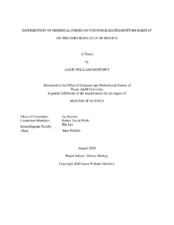| dc.contributor.advisor | Rooker, Jay | |
| dc.creator | Mostowy, Jason William | |
| dc.date.accessioned | 2021-02-22T18:02:56Z | |
| dc.date.available | 2021-02-22T18:02:56Z | |
| dc.date.created | 2020-08 | |
| dc.date.issued | 2020-07-23 | |
| dc.date.submitted | August 2020 | |
| dc.identifier.uri | https://hdl.handle.net/1969.1/192564 | |
| dc.description.abstract | Benthic habitat on the continental shelf in the northern Gulf of Mexico (NGoM) is dominated by large plains of unconsolidated terrigenous sediment. This unconsolidated bottom habitat (UBH) is presumed to be sparsely inhabited by demersal fishes, and little is known about the factors that structure the distribution and abundance of fishes on UBH. In this study, an integrated acoustic/video approach was employed to quantify the distribution of demersal fishes on UBH across the continental shelf off Texas. Split-beam echo sounder surveys were paired with simultaneous video from imaging sonar and standard cameras to determine the occurrence and density of demersal fishes on UBH. The relative performances of the different gear types at detecting and enumerating both demersal fishes and bottom relief anomalies were compared. Occurrence (presence/absence) and density of demersal fishes was then related to a suite of habitat and environmental variables using generalized additive models (GAMs) to identify the variables that contribute to the quality of UBH used by demersal fishes. Standard camera video performed poorly for detection and enumeration of demersal fishes as well as bottom relief anomalies associated with UBH due to the persistent nepheloid layer at all locations surveyed. Echo sounder and imaging sonar surveys showed similar performances in detecting fishes and relief anomalies, but their performance varied in enumerating both variables. GAMs constructed from the echo sounder dataset indicated that a shallow depth, high percent coverage and large size of relief anomalies, low salinity, warmer temperature and closer proximity to non-platform artificial structure positively influenced the quality of UBH for demersal fishes. Close proximity to active petroleum platforms had a slight negative influence. The results of this study provide insight into the factors that regulate the distribution and abundance of demersal fishes in the NGoM, and the methodological refinements developed here will guide future efforts to characterize populations of demersal fishes on UBH. | en |
| dc.format.mimetype | application/pdf | |
| dc.language.iso | en | |
| dc.subject | marine ecology | en |
| dc.subject | fisheries acoustics | en |
| dc.subject | demersal fishes | en |
| dc.subject | continental shelf | en |
| dc.subject | generalized additive models | en |
| dc.title | Distribution of Demersal Fishes on Unconsolidated Bottom Habitat of the Northern Gulf of Mexico | en |
| dc.type | Thesis | en |
| thesis.degree.department | Marine Biology | en |
| thesis.degree.discipline | Marine Biology | en |
| thesis.degree.grantor | Texas A&M University | en |
| thesis.degree.name | Master of Science | en |
| thesis.degree.level | Masters | en |
| dc.contributor.committeeMember | Wells, Robert | |
| dc.contributor.committeeMember | Liu, Hui | |
| dc.type.material | text | en |
| dc.date.updated | 2021-02-22T18:02:56Z | |
| local.etdauthor.orcid | 0000-0003-1601-7141 | |


